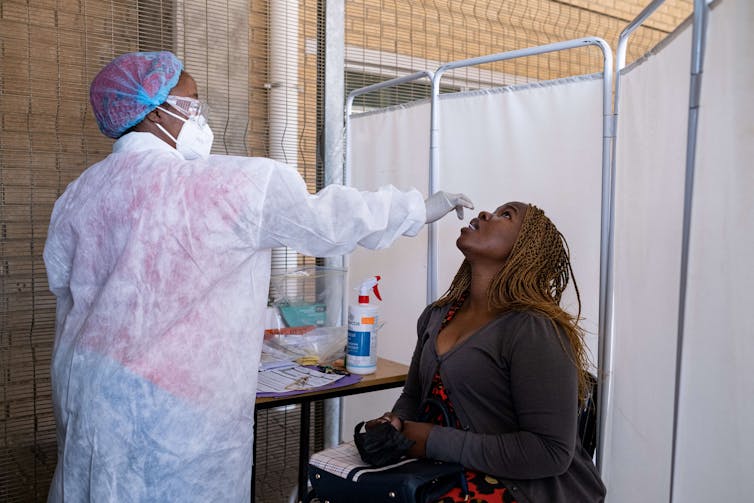
Omicron: evidence shows it evades immunity from earlier infection more than other variants

Cari van Schalkwyk, South African Centre for Epidemiological Modelling & Analysis (SACEMA) ; Harry Moultrie, National Institute for Communicable Diseases, and Juliet Pulliam, South African Centre for Epidemiological Modelling & Analysis (SACEMA)
Scientists are working around the clock to get a better understanding of the Omicron variant. Around the world countries have imposed travel bans to mitigate the spread. South African scientists first announced that they had identified a new variant on November 25 2021. Since then, cases of COVID have increased exponentially and South Africa has entered a fourth wave. Scientists from the South African DSI-NRF Centre of Excellence in Epidemiological Modelling and Analysis and the National Institute for Communicable Diseases) spoke to The Conversation Africa about their findings, which are set out in a pre-print paper.
How is Omicron different to previous variants?
Our key findings are around the risk of reinfection.
A reinfection is defined as a positive SARS-COV-2 test more than three months after a previous positive test. We found that the relative risk of reinfection was much higher (at least 3-fold) with the Omicron variant than it was with the Beta and Delta variants.
Our evidence suggests that the Omicron variant is associated with increased ability to evade immunity from prior infection. In contrast, there is no population-wide epidemiological evidence of increased immune escape associated with the Beta or Delta variants, compared with the original, or wild, type.
This finding has important implications for public health planning, particularly in countries like South Africa with high rates of immunity from prior infection. A study to measure previous infection found that just before the third wave (in May 2021) almost half of blood donors in South Africa had already been infected.
Another study, called PHIRST-C, that followed households through time found that more than 60% of individuals had been infected by the end of August 2021. As a result of this high level of prior infection, combined with around 40% coverage of vaccination among adults, a smaller fourth wave was expected.
But, if the virus mutates to increase its ability to evade natural immunity – like it seems to have done with Omicron – governments cannot rely on prior natural immunity to estimate the size of future outbreaks.
At this stage, we cannot say anything about the severity of cases with Omicron – either in primary or reinfections. We also do not have information on the vaccination status of reinfections.
Another big issue yet to be answered is whether protection against severe disease and death will be affected by reduced immunity to reinfection.
Several preprints have now come out suggesting Omicron could escape neutralisation in vaccinated people who had not also had a prior infection. These findings could help explain the large risk of reinfection. Early laboratory results looking at assays to measure T-cell-based immunity, on the other hand, predict that substantial protection against severe disease and death may remain.
Our findings were based on analysing surveillance data collected in South Africa between 04 March 2020 and 27 November 2021.
What do your findings say about vaccine efficacy?
Based on the data used in this study, we cannot say anything about the implications for this. We are hopeful that the vaccines will have similar efficacy against severe disease with Omicron than they have against other variants.
What can individuals do to minimise the impact of the 4th wave?
Even with the new variant, the key preventative measures that individuals can take remain wearing a mask, social distancing, improving ventilation, and vaccination. During the holiday season, it is particularly important to avoid large crowds, especially indoors. Until we have a better understanding of this variant, it is best not to gather with groups of friends, but if you do, please do it outside.![]()
Cari van Schalkwyk, Researcher in Statistics, South African Centre for Epidemiological Modelling & Analysis (SACEMA) ; Harry Moultrie, Senior medical epidemiologist, Centre for Tuberculosis, National Institute for Communicable Diseases, and Juliet Pulliam, Director: SACEMA, South African Centre for Epidemiological Modelling & Analysis (SACEMA)
This article is republished from The Conversation under a Creative Commons license. Read the original article.
















